Europe, British Isles, South-West England, Wiltshire, Stonehenge Landscape, Stonehenge Barrows, Winterborne Stoke Barrows, Winterbourne Stoke Down Barrows
Winterbourne Stoke Down Barrows is in Winterborne Stoke Barrows.
Europe, British Isles, South-West England, Wiltshire, Stonehenge Landscape, Stonehenge Barrows, Winterborne Stoke Barrows, Winterbourne Stoke Down Barrows, Winterbourne Stoke Down Barrow 1 G51 [Map]![]()
Colt Hoare 1812. The first barrow that occurs on leaving the British villages, is No. 1 [Map], situated at a short distance from the bank and ditch before mentioned, and near the road leading to Shrewton; it contained a very large interment of burned bones.
Europe, British Isles, South-West England, Wiltshire, Stonehenge Landscape, Stonehenge Barrows, Winterborne Stoke Barrows, Winterbourne Stoke Down Barrows, Winterbourne Stoke Down Barrow 2 G52 [Map]![]()
Colt Hoare 1812. No. 2 [Map] appeared to have had a prior opening.
Europe, British Isles, South-West England, Wiltshire, Stonehenge Landscape, Stonehenge Barrows, Winterborne Stoke Barrows, Winterbourne Stoke Down Barrows, Winterbourne Stoke Down Barrow 3 G53 [Map]![]()
Winterbourne Stoke Down Barrow 3 G53 is also in South England Neolithic Long Barrows.
Colt Hoare 1812. No. 3 [Map] is a long, or rather triangular barrow, standing nearly east and west, the broad end towards the former point; it measures 104 teet in length, 64 feet in width at the large end, 45 feet at the small end, and does not exceed three or four feet in elevation, This tumulus has been much mutilated, partly by former antiquaries, and partly by cowherds or shepherds, who had excavated the eastern end, by making huts for shelter. Our first section was made at the western end, but produced nothing. On making a second, we perceived the earth had been disturbed, and pursuing the section, found two or three fragments of burned bones. We next observed a rude conical pile of large flints, imbedded in a kind of mortar made of the martyr chalk dug near the spot. This rude pile was not more than four or five feet in the base, and about two feet high on the highest part, and was raised upon a floor, on which had been an intense fire, so as to make it red like brick. At first we conceived that this pile might have been raised over an interment, but after much labour in removing the greater part of it, we very unexpectedly found the remains of the Briton below, and were much astonished at seeing several pieces of burned bones intermixed with the great masses of mortar, a circumstance extremely curious, and so novel, that we know not how to decide upon the original intent of this barrow. The primary interment might have been disturbed before, or we might have missed the Britons might perhaps have burned the body by an intense fire on the spot, where the earth was made red; and the calcined bones might then have been collected together, and mixed in the mortar, which, with flints, formed the rude cone over the fire-place. If this opinion is right, the Britons in this case adopted a very singular method for preserving the dead. We have left some of the mortar containing the burned bones, near the top of the barrow, to satisfy the curiosity of any person who might wish to examine it. Though nearly the whole of the bones had slight tinge of green, we could not discover any articles of brass. On exploring this barrow further to the east, we found two deep cists containing an immense quantity of wood ashes, and large pieces of charred wood, but no other signs of interment.
Wiltshire Archaeological Magazine 1913 V38 Pages 379-414. Winterbourne Stoke. 53. [Winterbourne Stoke Down Barrow 3 G53 [Map]] On Winterbourne Stoke Down. Hoare's No. 3. Length 104ft.; E. and W. Opened by Hoare and Cunnington. They found a large pile of flints that had been "imbedded in a kind of mortar made of the marly chalk dug near the spot"; the flints were "raised upon a floor, on which had been an intense fire, so as to make it red like brick." Under the flints were "several pieces of burnt bones intermixed with the great masses of mortar, a circum- stance extremely curious, and so novel, that we did not know how to decide upon the original intent of this barrow." Hoare expresses some doubt as to whether they had found the primary interment. This barrow is a rather shapeless mass, wide and flat; the ditches are ill defined. Hoare says "that it has been much mutilated, partly by former antiquaries, and partly by cowherds or shepherds, who had excavated the eastern end by making huts for shelter." O.M. 54 S.W.; A. W. 1.117.
Compare Kill Barrow, under Tilshead. This barrow is not included in Thurnam's list of Long Barrows opened by Hoare and Cunnington. Arch. xlii. 180.
Wiltshire Museum. DZSWS:STHEAD.75a. 1 sandstone whetstone rubbed flat on two sides found with a primary (?) cremation in long barrow Winterbourne Stoke G53 [Map], excavated by William Cunnington.
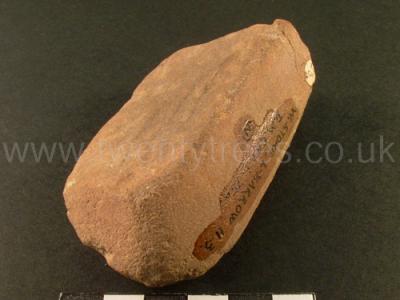
Wiltshire Museum. DZSWS:STHEAD.75b. 1 flint hammerstone found with a primary (?) cremation in long barrow Winterbourne Stoke G53 [Map], excavated by William Cunnington.
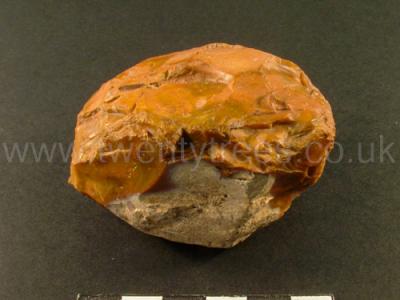
Europe, British Isles, South-West England, Wiltshire, Stonehenge Landscape, Stonehenge Barrows, Winterborne Stoke Barrows, Winterbourne Stoke Down Barrows, Winterbourne Stoke Down Barrow 4 G53a [Map]![]()
Colt Hoare 1812. No. 4 [Map] had been opened by a shepherd, and its history is unknown.
Europe, British Isles, South-West England, Wiltshire, Stonehenge Landscape, Stonehenge Barrows, Winterborne Stoke Barrows, Winterbourne Stoke Down Barrows, Winterbourne Stoke Down Barrow 6 G27 [Map]![]()
Colt Hoare 1812. Pursuing the line of barrows, we cross the great turnpike road, leading from Salisbury to Devizes, at milestone V Ill. from the former; nearly opposite to which stands No. 6 [Map], which we found had been explored by some prior investigator.
Europe, British Isles, South-West England, Wiltshire, Stonehenge Landscape, Stonehenge Barrows, Winterborne Stoke Barrows, Winterbourne Stoke Down Barrows, Winterbourne Stoke Down Barrow 7 G26 [Map]![]()
Colt Hoare 1812. No. 7 [Map] is a fine bell-shaped barrow, 122 feet in diameter, and 9 feet in elevation. After great labour in making a spacious excavation, we unfortunately missed the interment; but from finding the fragment of a very large urn, and a few burned bones, we have some reason to think the barrow might have been opened before.
Europe, British Isles, South-West England, Wiltshire, Stonehenge Landscape, Stonehenge Barrows, Winterborne Stoke Barrows, Winterbourne Stoke Down Barrows, Winterbourne Stoke Down Barrow 8 G25 [Map]![]()
Colt Hoare 1812. No. 8 [Map]. This barrow, rather inclined to the bell shape, is 82 feet in diameter, and in elevation. It contained within a shallow oblong cist, the burned bones (as we conceived) of two persons piled together, but without arms or trinkets. In excavating the earth from this barrow, our men found a piece of square stone polished on one side, having two marks cut into it, also a whetstone.
Europe, British Isles, South-West England, Wiltshire, Stonehenge Landscape, Stonehenge Barrows, Winterborne Stoke Barrows, Winterbourne Stoke Down Barrows, Winterbourne Stoke Down Barrow 9 G24 [Map]![]()
Colt Hoare 1812. No. 9 [Map], a small barrow not above sixteen inches in elevation, produced, six feet apart, the horns of two large stags, and between them a sepulchral urn inverted over a pile of burned bones. This urn is rudely made, yet elegant in its outline.1 On digging deeper, we discovered the skeleton of an adult lying with its head to the south; and on pursuing our researches to the depth of four feet in the native bed of chalk, we found another skeleton with its head placed towards the north; bat each of these interments was unaccompanied by any warlike or decorative articles.
Note 1. See Plate XVI.
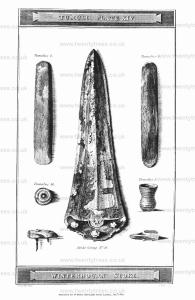
Wiltshire Museum. DZSWS:STHEAD.263. 1 food vessel with wide spreading rim containing stab marks and two ridges notched with finger impressions around waist, found inverted over a secondary cremation near the surface in bowl barrow Winterbourne Stoke G24 [Map], excavated by William Cunnington.
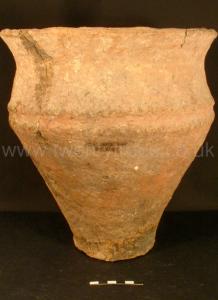
Europe, British Isles, South-West England, Wiltshire, Stonehenge Landscape, Stonehenge Barrows, Winterborne Stoke Barrows, Winterbourne Stoke Down Barrows, Winterbourne Stoke Down Barrow 10 G23a [Map]![]()
Colt Hoare 1812. No. 10 [Map]. In this small tumulus, which appears to have been partially opened before, found an oblong cist, which was arched over with the chalk that had been thrown out of it; and in the further part of it, a few fragments of burned bones, and a large glass bead, of the same imperfect vitrification as the pully beads so often before mentioned, and resembling also in matter, the little figures that are found with the mummies in Egypt, and are to be seen in the British Museum. This very curious bead has two circular lines of opaque sky blue and white, which seem to represent a serpent intwined round a centre, which is perforated. This was certainly one of the Glain Neidyr of the Britons, derived from glain, what is pure and holy, and neidyr, a snake. Under the word glain, Mr. Owen, in his Welsh Dictionary, has given the following article: "The main glain, transparent stones, or adder-stones, were worn by the different orders of the Bards, each having its appropriate colour. There is no certainty that they were worn from superstition originally; perhaps that was the circumstance which gave rise to it. Whatever might have been the cause, the notion of their rare virtues was universal in all places where the Bardic religion was taught. It may still be questioned whether they are the production of nature or art." Mr. Mason, the poet, thus alludes to these stones,
.... But tell me yet
From the grot of charms and spells,
Where our matron sister dwells,
Brennus, has thy holy hand
Safely brought the Druid wand,
And the potent adder-stone,
Gender'd fore th' autumnal moon?
When in undulating twine
The foaming snakes prolific join;
When they hiss, and when they bear
Their wond'rous egg aloof in air;
Thence, before to earth it fall,
The Druid in his holy pall,
Receives the prize,
And instant flies,
Follow 'd by the envenom'd brood,
Till he cross the silver flood.
Wiltshire Museum. DZSWS:STHEAD.79. 1 glass bead with blue and white spiral pattern, found with (?) a Saxon (?) primary cremation in bowl barrow Winterbourne Stoke G23a [Map], excavated by William Cunnington.
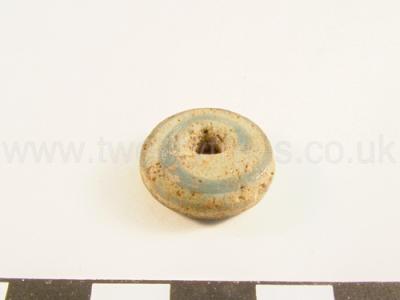
Europe, British Isles, South-West England, Wiltshire, Stonehenge Landscape, Stonehenge Barrows, Winterborne Stoke Barrows, Winterbourne Stoke Down Barrows, Winterbourne Stoke Down Barrow 11 G23 [Map]![]()
Colt Hoare 1812. No. 11 [Map] is a pond barrow.